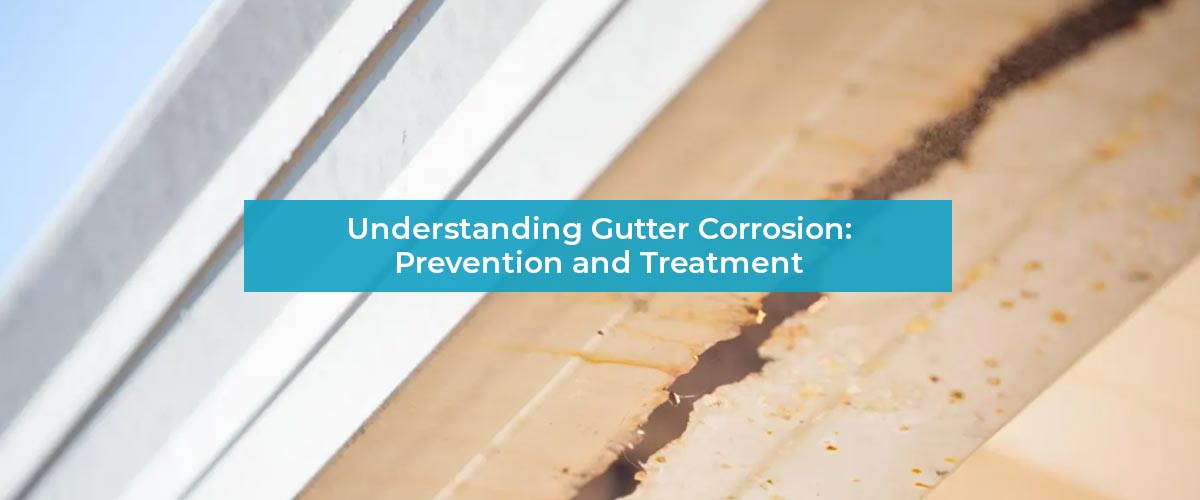Gutters are an essential component of any home’s exterior, tasked with the critical responsibility of channelling rainwater away from the roof and foundation. However, over time, gutters are susceptible to corrosion—a natural process that can compromise their structural integrity and effectiveness. Understanding gutter corrosion, its causes, prevention methods, and treatment options is crucial for maintaining a functional gutter system and protecting your home from water damage. In this comprehensive guide, we’ll delve into the intricacies of gutter corrosion and provide insights on how to prevent and treat this common issue.
1. The Causes of Gutter Corrosion
Gutter corrosion occurs when metals, such as aluminium, steel, or galvanised iron, react with environmental elements or substances, leading to deterioration of the gutter material. Several factors contribute to gutter corrosion, including:
- Exposure to Moisture: Gutters are constantly exposed to moisture from rain, snow,(not commonly in Perth, or Western Australia) and dew, making them susceptible to corrosion, particularly if they remain wet for extended periods.
- Chemical Reactions: Chemicals present in rainwater, such as sulphur dioxide and nitric acid, can react with metal gutters, accelerating the corrosion process.
- Debris Accumulation: Accumulated debris, such as leaves, twigs, and dirt, in gutters can trap moisture and create an acidic environment conducive to corrosion.
- Environmental Factors: Exposure to salt spray, pollutants, and airborne contaminants can exacerbate gutter corrosion, especially in coastal or industrial areas.
2. Types of Gutter Corrosion
Gutter corrosion can manifest in various forms, each with distinct characteristics and implications for gutter maintenance and repair. Common types of gutter corrosion include:
- Rusting: Rust is a type of corrosion that occurs when iron or steel gutters react with oxygen and moisture, forming iron oxide (rust) on the surface. Rust weakens the metal, leading to structural deterioration and eventual failure if left untreated.
- Galvanic Corrosion: Galvanic corrosion occurs when two dissimilar metals come into contact in the presence of an electrolyte, such as water. The more reactive metal corrodes while the less reactive metal remains intact, resulting in localised damage along the interface.
- Pitting Corrosion: Pitting corrosion is characterised by the formation of small pits or cavities on the surface of metal gutters, caused by localised chemical reactions. Pitting corrosion can weaken the gutter material and compromise its structural integrity over time.
- Uniform Corrosion: Uniform corrosion occurs evenly across the surface of the gutter material, resulting in gradual thinning and deterioration. While less visually striking than other forms of corrosion, uniform corrosion can still compromise gutter performance and longevity.
3. Prevention of Gutter Corrosion
Preventing gutter corrosion requires proactive measures aimed at minimising exposure to corrosive elements and maintaining optimal gutter conditions. Key strategies for preventing gutter corrosion include:
- Regular Cleaning: Keeping gutters clean and free of debris helps prevent moisture buildup and reduces the risk of corrosion. Regular gutter cleaning also allows for early detection of corrosion and facilitates timely intervention.
- Installation of Gutter Guards: Gutter guards act as barriers, preventing debris from accumulating in gutters and reducing the likelihood of corrosion. By minimising exposure to moisture and contaminants, gutter guards help prolong the lifespan of metal gutters.
- Proper Drainage: Ensuring proper drainage of rainwater away from the roof and foundation helps prevent water from pooling in gutters and creating conditions conducive to corrosion. Properly installed downpipes and drainage systems are essential for effective water management.
- Routine Inspections: Conducting routine inspections of gutters allows for early detection of corrosion, leaks, and other issues that may compromise gutter performance. Prompt repairs and maintenance can help mitigate corrosion and extend the lifespan of gutters.
4. Treatment of Gutter Corrosion
In cases where gutter corrosion has already occurred, prompt treatment is necessary to prevent further deterioration and restore gutter functionality. Treatment options for gutter corrosion may include:
- Rust Removal: Removing rust from metal gutters involves abrasive cleaning methods, such as wire brushing or sanding, followed by the application of rust-inhibiting primers and coatings to prevent future corrosion.
- Patching and Sealing: Patching small areas of corrosion with epoxy or metal patches and sealing seams and joints with waterproof sealants can help prevent further water intrusion and corrosion progression.
- Replacement: In severe cases of gutter corrosion where repair is not feasible, replacement of the affected gutter sections may be necessary to restore functionality and prevent water damage.
In conclusion, understanding gutter corrosion, its causes, prevention methods, and treatment options is essential for maintaining a functional gutter system and protecting your home from water damage. By implementing proactive maintenance practices, such as regular cleaning, installation of gutter guards, and routine inspections, you can minimise the risk of gutter corrosion and prolong the lifespan of your gutters. If you suspect gutter corrosion or require professional assistance, don’t hesitate to call WA Gutter Suckers today on 0475 280 804 for expert advice and services. Let us help you safeguard your gutters and preserve the integrity of your home.


